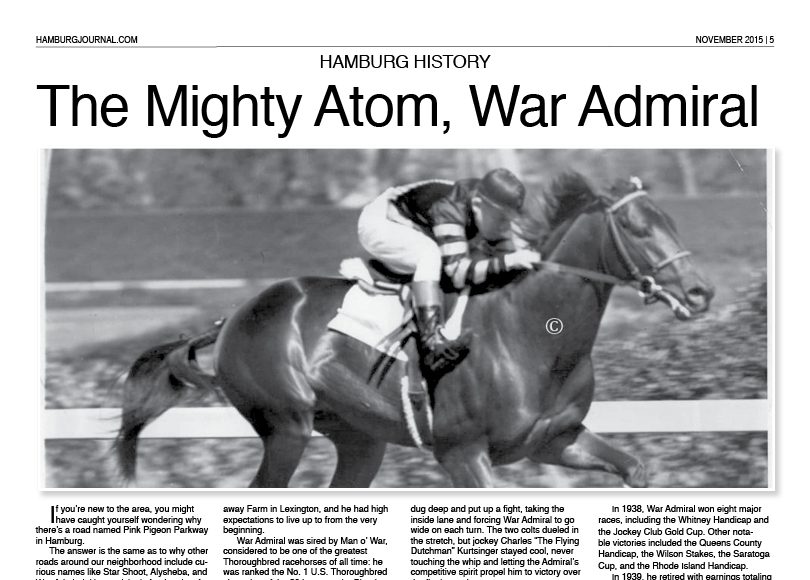Hamburg History: The Mighty Atom, War Admiral
 If you’re new to the area, you might have caught yourself wondering why there’s a road named Pink Pigeon Parkway in Hamburg.
If you’re new to the area, you might have caught yourself wondering why there’s a road named Pink Pigeon Parkway in Hamburg.
The answer is the same as to why other roads around our neighborhood include curious names like Star Shoot, Alysheba, and War Admiral. Unsurprisingly for the city of Lexington — the horse capital of the world — it has to do with horse racing.
In fact, the name of the Hamburg Pavilion itself has to do with this area’s rich history.
Our neighborhood is named after a horse, Hamburg, the thoroughbred that John Madden purchased in 1896 and set about turning into a record breaking racehorse.
Madden’s 235-acre farm, which occupied most of the land where so many of us live and work today, was named Hamburg Place (in honor of the horse).
Hamburg Place produced four Belmont Stakes winners, four Kentucky Derby winners, and the first Triple Crown winner.
Lexington was also home to another Triple Crown winner whose name is now a part of the Hamburg landscape.
Let’s delve into the history of War Admiral.
War Admiral was born in 1934 at Faraway Farm in Lexington, and he had high expectations to live up to from the very beginning.
War Admiral was sired by Man o’ War, considered to be one of the greatest Thoroughbred racehorses of all time: he was ranked the No. 1 U.S. Thoroughbred champion of the 20th century by Blood-Horse magazine, and also ranked No. 1 by the Associate Press in a separate poll.
Admiral inherited his father’s fiery temperament and talent, but was much smaller physically, measuring 15.3 hands (a little more than 5 feet).
He also inherited the success. War Admiral won 21 of his 26 starts, including the US Triple Crown in 1937.
Entering that year, only three horses, one of which was Sir Barton, had won the Triple Crown. However, owner Samuel D. Riddle decided to enter War Admiral in the Kentucky Derby to give him a chance to win it.
Although Pompoon was the best of the 2-year-old crop in 1936, War Admiral was the favorite to win the Derby thanks to a record of impressive wins. The Run for the Roses wasn’t even a challenge to the Admiral, as he quickly took the lead and never looked back.
The Preakness, which was only a week later, posed more of a challenge. Pompoon dug deep and put up a fight, taking the inside lane and forcing War Admiral to go wide on each turn. The two colts dueled in the stretch, but jockey Charles “The Flying Dutchman” Kurtsinger stayed cool, never touching the whip and letting the Admiral’s competitive spirit propel him to victory over the final stretch.
Admiral again displayed his fiery disposition (some fans even took to calling him The Mighty Atom) during the Belmont Stakes. He delayed the race for more than eight minutes at the starting gate, dragging a bewildered assistant through the gate several times before the thoroughbred could be contained. When the race finally began, the fiery competitor stumbled out of the gate, and cut an inch-square chunk out of his right forefoot with his hind foot.
However, instead of giving up, he persevered through adversity, roaring to a three-length victory in a virtuoso performance that broke the track record set by his sire Man o’ War 17 years earlier.
War Admiral’s success was such that he even won 1937 American Horse of the Year, beating his nephew Seabiscuit (who would go on to win it in 1938) by 621 votes to 603. Nonetheless, Admiral lost his only match race against the legend, the Pimlico Special on November 1, 1938.
In 1938, War Admiral won eight major races, including the Whitney Handicap and the Jockey Club Gold Cup. Other notable victories included the Queens County Handicap, the Wilson Stakes, the Saratoga Cup, and the Rhode Island Handicap.
In 1939, he retired with earnings totaling $273,240.
His legacy was also significant. He was the leading American sire in 1945 and the leading juvenile sire in 1948. Before his death in 1959, War Admiral had sired 40 stakes winners, including Blue Peter, Searching, Busanda, Mr. Busher, Navy Page, Cold Command, and Admiral Vee. He also sired Busher, champion filly and a Horse of the Year.
Following in his father’s footsteps, War Admiral has been elected to the National Museum of Racing and Hall of Fame and ranks #13 in Blood-Horse’s top 100 US thoroughbred champions of the 20th century. And he did achieve one thing his sire had never done: winning the Kentucky Derby.
And now you know a little bit more about the distinguished horse-racing history of the city of Lexington and Hamburg itself, and the street names around this area, too.
This article also appears on page 5 of the November issue of the Hamburg Journal.
For more Hamburg area news, subscribe to the Hamburg Journal weekly digital newsletter.












